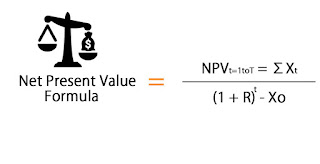Organizations like to adopt the net present value method to gain insight for investment related context in a capital project. It is one of the most effective techniques of capital budgeting, to find the approximation value of profit from a specific project. It concerns on a payback period and discounted payback period methods to summarize the detail of the budget, with the calculation of the rate of return within an organization and profitability index. Students who have chosen a business in their graduation can take capital budgeting assignment help from our experts. Capital budgeting specifically has three methods to estimate the result of a new project. NPV (Net Present Value) is one of them and it is considered to get a rough idea of project productivity in the market.
What Is NPV (Net Present Value)?
NPV ( Net present value) is used to determine the present value of the discounted cash flows from a new investment project or in other words, an organization like to invest in the potential project by using this method. It has multiple scopes and can help an organization to gain profit on a large scale. It can be an investment in constructing a road, railway or building and buying expensive materials for a certain business.
It is commonly used by entrepreneurs to choose the project with the best outcome and for the return of invested amount on it. If the estimated result of the project is positive, then the company will invest in the project. On the other hand, the negative result will allow the firm to drop the plan.
How to Select Capital Projects?
One need to consider a few concern areas before calculating net present value, such as the project is independent or mutually dependent. The cash flow of other projects does not affect the independent project, whereas, the two joint projects or mutually exclusive projects are bound by certain rules. Suppose you requested a tender and received it, then you can apply this for both the project. One needs not to apply it for the other project.
Decision Rules for Net Price Value
If the payback of the investment is getting returned in the selected period, then you can accept the proposal. It is equally liable for the discounted payback period method. One can evaluate the NPV of the project for the selection of the potential project. For independent projects if the NPV is greater than zero, then you should accept the proposal. On the other hand, in the mutually exclusive project, the competing value of the project can be ease out by selecting the one with the higher NPV value.
To find out the present value of cash flow, a basic equation is considered:
NPV(p)
= CF(0) + CF(1)/(1 + i )t + CF(2)/(1 + i)t +
CF(3)/(1 +i )t + CF(4)/(1 +i )t
Where:
i = (firm's)
cost of capital
t
= the year in which the cash flow is received
CF
(0) = initial investment
It
acts as a referencing guide to the investors to find the
approximate value of the capital required for completion of project.
Disadvantages of NPV
There are many drawbacks of the NPV as the
approximation value is in the decimal or the fraction form, it often led problem
or confusion to determine the exact value especially in counting the number of
labour force required to complete the work. Besides, some unpredicted events
affect the cost and cash flow of the project. It only focuses on the estimated
result, the time delays, additional expenses are not evaluated by this method.
However, the calculation does not hold all kinds of risk. It is a mere
assumption made by investors to get the rough idea of capital needed to run the
project
BookMyEssay,
like to provide you last minute assignment help if you require it. Contact us on the company official
website for more information.









No comments:
Post a Comment
Note: only a member of this blog may post a comment.